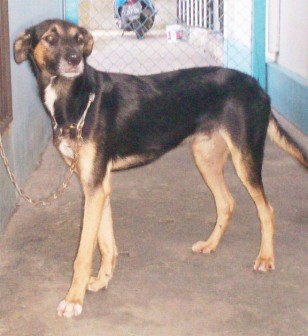Strychnine
In the past, many of the rat poisons contained strychnine. I don’t know if it is still legal to bring strychnine into Guyana to be used in rat bait. It was effective in the past, so I do believe that, in spite of the success of newer rat poisons, strychnine might be available for use (and misuse and abuse) as a rodenticide.
In order to entice the rats to eat the poison, pellets are produced with strychnine and then alluringly coated in attractive colours. 
The symptoms start showing themselves within 10 minutes to two hours after ingestion. They include:
● Agitation/excitability
● Apprehension, nervousness
● Tenseness and stiffness
● Painful cramps
● Seizures lasting for about 60 seconds and then periods of relaxation
● The head of the dog is thrown backwards
● The animal has difficulty in breathing
● Cyanosis (the animal’s tongue and body become blue from the lack of oxygen and the accumulation of carbon dioxide)
● Any stimulation (eg, the snapping of your figures or the clapping of hands) can precipitate a further seizure and tremors
● Gnashing of teeth
● Drooling
● Uncoordinated muscle spasms
● Lateral recumbency (the animal lies on its side and paddles its legs)
● The dog may lose control of its bladder

Because strychnine attacks the central nervous system, we often misdiagnose this type of poisoning with epilepsy seizures (fits). To establish a diagnosis of epilepsy, the attacks must be recurring often and they must be similar in expression.
A typical epileptic fit has pretty much distinct phases that are different from those associated with strychnine poisoning. For example, before a genuine epileptic seizure, the dog behaves in a bizarre manner; it snaps at the air or sniffs at corners, and such like. The animal collapses and becomes rigid. After a while, it recovers, but remains confused and wobbly. In the case of strychnine poisoning, any recovery (if at all) will take days. In all likelihood the animal will die within two hours, if you do not follow the advice given below, and if there is no professional veterinary intervention.
Treatment
Try to induce vomiting as described previously (see December 5, 2010). Of course, if the nervous system symptoms are already very pronounced, it is of no use to make the animal throw up; the poison is already in its system. If you have any active charcoal capsules (such medication should be in the First Aid Kit which every home should have), give the animal one or two capsules orally. Don’t make any loud noises that could excite the animal. Keep the animal warm. Very quietly, carry the dog to your veterinarian. He/she will take it from there. Bear in mind that ingested strychnine could be broken down within 24 hours. Speed of treatment is essential.
Actually, the specific treatment that the vet will introduce has all to do with supportive interventions. There is no antidote as such. If the animal is not convulsing, the vet will try to incite vomiting. If the animal is exhibiting seizures, I always administer a short-acting sedative or anaesthetic (especially for short-term seizure control). The vet would probably try to wash out the stomach, if he/she received the patient within half an hour of the strychnine ingestion.
Let’s try to keep chemical compounds that contain strychnine (eg, certain rat baits) far away from pets.





